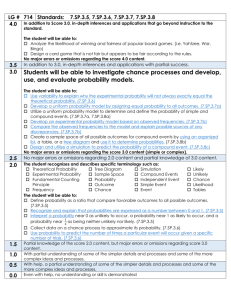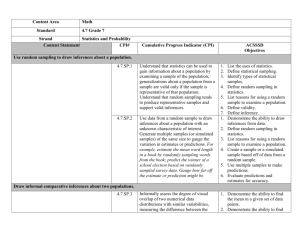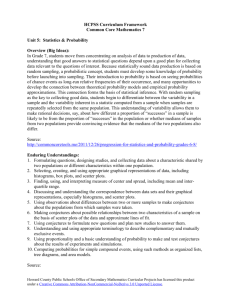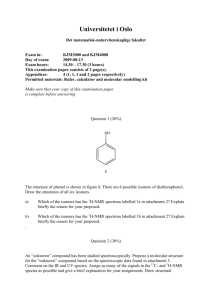Day 2 Gr7 Math Chart for Unit Review Key
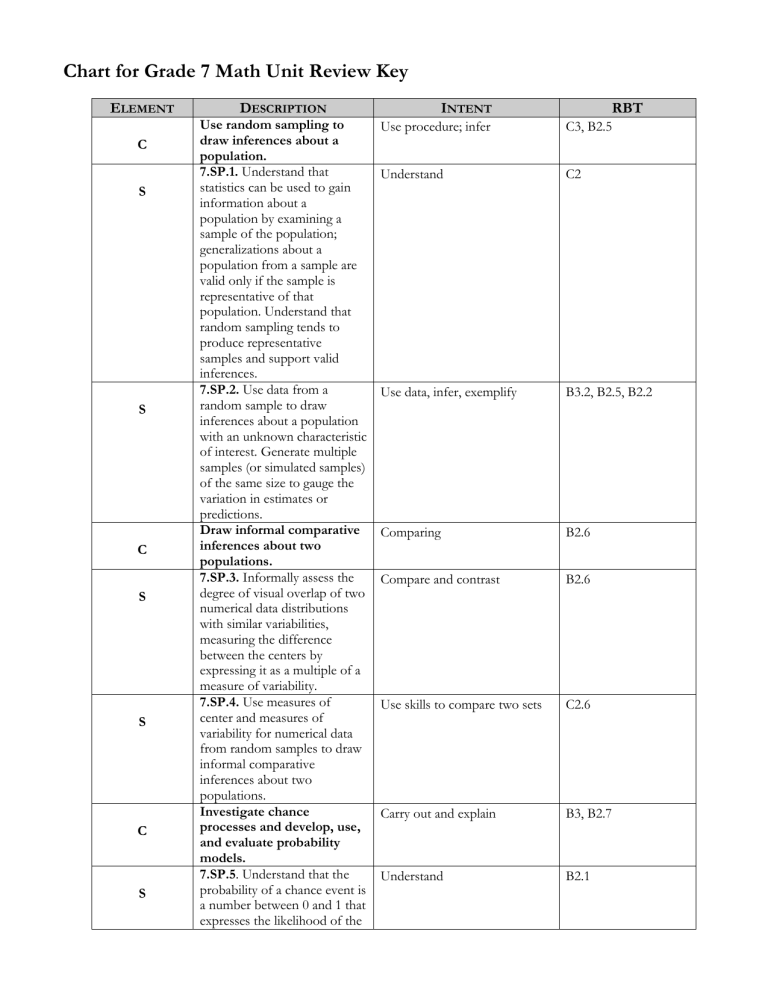
Chart for Grade 7 Math Unit Review Key
E LEMENT
C
S
S
C
S
S
C
S
D ESCRIPTION
Use random sampling to draw inferences about a population.
7.SP.1. Understand that statistics can be used to gain information about a population by examining a sample of the population; generalizations about a population from a sample are valid only if the sample is representative of that population. Understand that random sampling tends to produce representative samples and support valid inferences.
7.SP.2. Use data from a random sample to draw inferences about a population with an unknown characteristic of interest. Generate multiple samples (or simulated samples) of the same size to gauge the variation in estimates or predictions.
Draw informal comparative inferences about two
populations.
7.SP.3. Informally assess the degree of visual overlap of two numerical data distributions with similar variabilities, measuring the difference between the centers by expressing it as a multiple of a measure of variability.
7.SP.4. Use measures of center and measures of variability for numerical data from random samples to draw informal comparative inferences about two populations.
Investigate chance processes and develop, use, and evaluate probability models.
7.SP.5. Understand that the probability of a chance event is a number between 0 and 1 that expresses the likelihood of the
I NTENT
Use procedure; infer
Understand
Use data, infer, exemplify
Comparing
Compare and contrast
Carry out and explain
Understand
C3, B2.5
C2
B3.2, B2.5, B2.2
B2.6
B2.6
Use skills to compare two sets C2.6
B3, B2.7
B2.1
RBT
E LEMENT
S
S
O
O
S
O
O
I
O
D ESCRIPTION event occurring.
7.SP.6. Approximate the probability of a chance event by collecting data on the chance process that produces it and observing its long-run relative frequency, and predict the approximate relative frequency given the probability.
7.SP.7. Develop a probability model and use it to find probabilities of events.
Compare probabilities from a model to observed frequencies; if the agreement is not good, explain possible sources of the discrepancy.
Develop a uniform probability model by assigning equal probability to all outcomes, and use the model to determine probabilities of events.
Develop a probability model
(which may not be uniform) by observing frequencies in data generated from a chance process.
7.SP.8. Find probabilities of compound events using organized lists, tables, tree diagrams, and simulation.
Understand that, just as with simple events, the probability of a compound event is the fraction of outcomes in the sample space for which the compound event occurs.
Represent sample spaces for compound events using methods such as organized lists, tables and tree diagrams.
For an event described in everyday language (e.g.,
“rolling double sixes”), identify the outcomes in the sample that compose the event.
Design and use a simulation to generate frequencies for compound events.
Practice in Teams
(Attachment #5)
Construct a model and compare
Construct a model and summarize
Construct a model and compare
Translate and illustrate using methods
RBT
Carry out a procedure and infer C3.1, C2.5
Carry out a procedure
Understand a concept
Explain
I NTENT
B2.7, B2.6
B2.7, B2.4
B2.7, B2.6
C3.1
B2.5
C2.1, C2.6
C2.2, C3.2
Select book and counting letters B2, C3
E LEMENT
I-2
A-1
I-3
I-4
I-5
A-2
A-3
I-6
I-7
I-8
A-4
A-5
I-9
A-6
A-7
D ESCRIPTION I NTENT RBT
Closing Activities
(Attachment #6)
Pre-assessment
(Attachment #4)
Engage
Explore
Practice
Homework
Set up probability ratio
Play dice game
Class completes theoretical distribution table
Dice game Evaluate Understanding
(Attachment #9)
Enrichment/Extension Homework question
Engage, explore & explain Tree diagram
B2
B2, C3
B2, C3
B2, C3
C3.1
B2.5, B2.6, B2.7
C3
B2.5, B2.1
Practice in Teams Students complete probability table
C3.1
Practice together (fairness) Class evaluates game for fairness B2.5
C3, B2, B6 Evaluate Understanding
(Attachment #10
Closing activities
(Attachment #13)
Homework problems on probability
C3
B2 Engage, explore, explain &
practice (Punnett Squares)
Evaluate Understanding
Closing activities
Teacher & students construct
KWL chart
Probability problem
Homework – attachment #15; 6 word problems on probability
C3
C3
A-8 Post-assessment B2, C3
(Attachment #17)
Element: Cluster (C), Standard (S), Objective (O), Instructional Activity (I), and Assessment (A)

